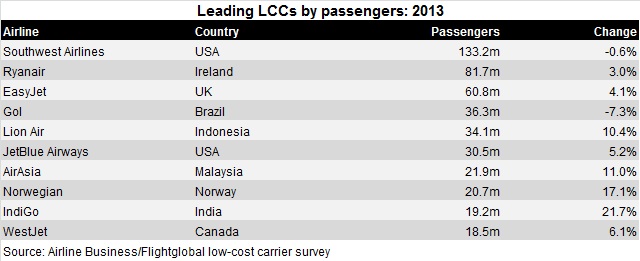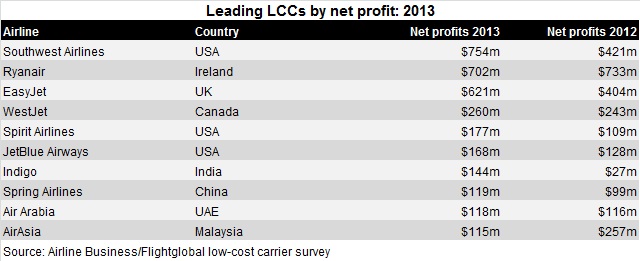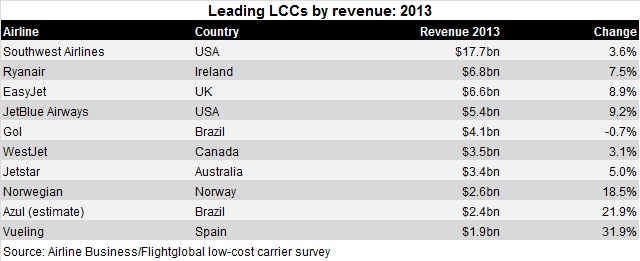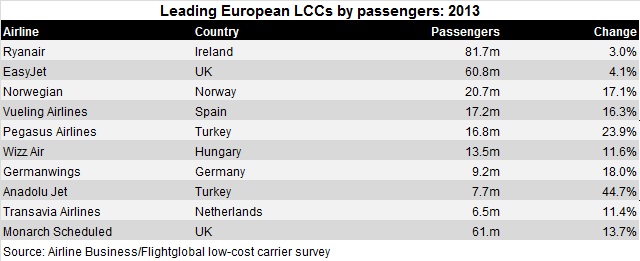Traffic and profitability among the fast-developing low-fares sector continued to grow apace in 2013, as the latest annual Airline Business/Flightglobal low-cost carrier survey shows passengers for the 75 biggest players topping 800 million and profits among leading operators jumping 50%.
Passenger growth for low-cost carriers rose 9.9% over the course of the year, as the model continues to spread within mature and emerging markets. The leading 75 airlines operating within the increasingly diverse sector carried just over 800 million in 2013.
Established operators Southwest, Ryanair and EasyJet, which carried 275 million passengers between them last year, had relatively moderate growth – indeed, Southwest passenger numbers fell fractionally.

But there was double-digit growth for a host of other low-cost carriers, notably the likes of Lion Air, AirAsia and Indigo in Asia-Pacific and expanding European operators Norwegian, Pegasus Airlines and Vueling.
While Gol continued to pull back capacity last year, another Brazilian carrier, Azul, is growing sharply – not just in size, but also, in future, into long-haul markets. Other Latin carriers, such as Interjet and Volaris of Mexico, also grew fast.
The leading 75 LCCs operate a combined fleet of 3,572 aircraft. Interestingly, after a further flurry order activity they have all but the same number of aircraft on order.
The growth in passengers among low-cost operators also brought with it an increase in profitability over the last financial year. Operating profits for nearly 40 airlines in the sector reached almost $6 billion in 2013, up on the $4 billion the same carriers made in 2012. Collective net profits for low-cost players stood just shy of $3 billion, showing an increase of nearly $1 billion.

The profits were based on collective revenues of $83.8 billion for nearly 50 low-cost carriers in their last financial year. More than 20 low-cost operators now generate sales of at least $1 billion annually, reflecting how the model is maturing across the different regions.

Southwest, including AirTran, remains the largest low-cost operator in the Americas, carrying 133 million passengers during 2013. Despite its pulling back capacity and a 7% cut in passengers, Brazilian carrier Gol remains the second-largest LCC in the region with 36 million passengers. JetBlue is the third-largest operator with just over 30 million passengers.

In Europe, Ryanair and EasyJet continue to be among the largest operators, carrying over 140 million passengers among them. But other European operators expanded rapidly behind them, and Norwegian, Vueling, Pegasus and Wizz Air each carried more than 10 million passengers last year.

Indonesian carrier Lion Air is the largest budget carrier in Asia-Pacific, carrying 34.1 million passenger last year. AirAsia lifted passenger numbers 11% to just under 22 million, while some of its regional ventures – including Thai AirAsia and Indonesia AirAsia – also carried significant passenger numbers over the course of the year.

The full low-cost carrier survey, covering traffic data for 75 operators and financial information for nearly 50 LCCs, is published in the June issue of Airline Business and will be available on the reports section of Flightglobal’s dashboard shortly.
Source: Cirium Dashboard
















